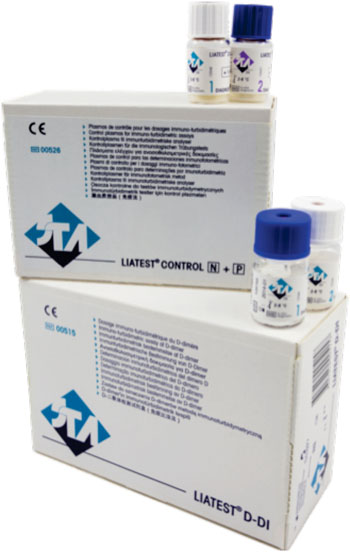D-dimer Assay for Exclusion of Pulmonary Embolism First to Meet Advanced Standards
By LabMedica International staff writers
Posted on 01 Oct 2014
For the first time a D-dimer assay for exclusion of pulmonary embolism (PE) meets the US Food and Drug Administration (FDA)’s approval requirements now based on the new and more restrictive standards established by the Clinical Laboratory Standards Institute (CLSI, H59-A).Posted on 01 Oct 2014
Diagnostica Stago, Inc. (Parsippany, NJ, USA), the US subsidiary of Diagnostica Stago, S.A.S. (Asnières sur Seine, France), a leader in development and manufacture of hemostasis products for clinical research and routine analysis, received the FDA clearance for the reagent “STA-Liatest D-Di” for the exclusion of PE in patients with low or moderate risk, presenting at an emergency unit. Stago’s rapid, automated, and highly sensitive D-dimer assay is the first to comply with the higher standards.

Image: The rapid, automated, highly sensitive “STA-Liatest D-Di” – the first D-dimer assay for exclusion of pulmonary embolism to meet the FDA’s approval requirements now based on the new, higher standards established by the Clinical Laboratory Standards Institute (Photo courtesy of Diagnostica Stago).
In order to comply with the new CLSI guidelines, Stago performed a 2-year, international, prospective study, similar to clinical studies performed in the pharmaceutical field—9 sites, 5 countries, more than 1,100 patients, including evaluation of clinical pretest probability, imaging, and 3 months of follow-up—a first in the field of hemostasis diagnostics. As its coordinator, Prof. Gilles Pernod of Grenoble University Hospital (France) pointed out: “As well as providing the results required to validate this test for the exclusion of PE, this study brought to light a significant evolution of clinical practices and shifts in prevalence. In fact, these results will be presented in some interesting upcoming publications.”
This study also confirmed the excellent diagnostic performance of the STA-Liatest D-Di assay, with a very high negative predictive value (NPV) for the exclusion of PE, far exceeding FDA requirements (>99.7% versus 97%), and excellent sensitivity (>97% versus 95%). “STA-Liatest D-Di is the first D-Di assay to report comprehensive study data that focuses on US-specific care patterns in the package insert. Increases in FDA stringency raises the bar for demonstration of clinical utility and patient safety. Stago is proud for STA-Liatest D-Di to lead the way once again and set the standard for D-dimer assays,” said Stephane Zamia, PhD, CEO of Diagnostica Stago, Inc.
The second part of this international clinical study, concerning deep vein thrombosis (DVT), is underway and is due to be completed in the next few months, with the hope that it will provide the clinical science community with as much relevant data as the first.
Related Links:
Diagnostica Stago (US)
Diagnostica Stago









 assay.jpg)




